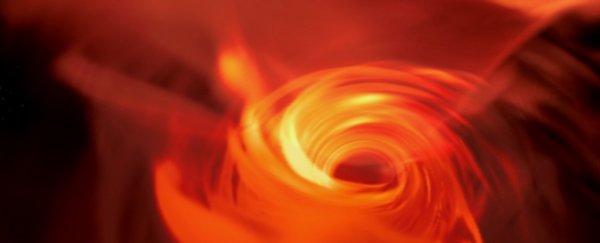Supermassive black holes may be the gravitational glue that binds a galaxy, but they're also a colossal puzzle. One mystery that has vexed astronomers: how do heck do black holes end up so roly-poly?
Take Sagittarius A*, the supermassive black hole at the centre of the Milky Way. It is about four million times the mass of the Sun, and it's not even close to being the biggest one out there.
A stellar core that collapses into a black hole will retain its pre-black hole mass in a much smaller, denser space - which means black holes gain mass by gobbling up - or accreting - matter from beyond their event horizon.
But supermassive black holes are so huge, the core collapse model seen in stellar black holes simply might not apply (especially since we're not even sure there are any black holes between these two sizes).
Now a team of astronomers may have uncovered a clue as to how these supermassive black holes reach such a ginormous size.
They have caught one of these black holes in the act of devouring matter - in a way that has never been seen before.
Previously, it had been thought that supermassive black holes had two 'feeding' modes. The first is known as a tidal disruption event, which is when a black hole catches a passing star in its gravitational net, violently tearing it apart and accreting at least some of it.
The second is an active galactic nucleus, which is the near-continuous accretion of dust and gas from a disc that swirls around the black hole, like water going down a drain.
Both these events produce a specific, recognisable signature across a variety of spectra - a sudden, brief spike that only lasts a few months for a tidal disruption event; or a lower, continuous signal that lasts several years for an active galactic nucleus.
What astronomers using the ASAS-SN network have spotted is an all-new type of signal, coming from an event called AT 2017bgt, spotted around a supermassive black hole 14 million times the mass of the Sun.
"The sudden brightening of AT 2017bgt was reminiscent of a tidal disruption event," said astrophysicist Benny Trakhtenbrot of ETH Zurich.
"But we quickly realised that this time there was something unusual. The first clue was an additional component of light, which had never been seen in tidal disruption events."
He and his team collected over a year's worth of data on the black hole, and finally came to the conclusion that it did not match any black hole feeding events observed before.
What they saw was that the optical and ultraviolet emission around the black hole increased by about 50 percent for over a year, and the X-ray emission by several factors, before dying down.
They believe that it may have been caused by the black hole feeding on gas from the space around it, but more work is needed to confirm, since it would have to be rather a lot of gas - more than the mass of a star, it seems from the data.
"An [active galactic nucleus] is like getting rained on - a constant trickle that might vary a bit in intensity, but lasts for a while. A tidal disruption event is like getting hit by a sprinkler - there's just one stream of water, and it might be more intense than rain," explained astronomer Andy Howell of Las Cumbres Observatory.
"But this new kind of flare is like getting hit by a firehose in the face. Now we have to figure out, 'How the hell did nature produce that that?' Black holes are even weirder than we thought."
In their paper, the team identified two other recent black hole feeding events with the same signature, which means the odds are good that AT 2017bgt wasn't just a freak occurrence. It also means odds are good that this type of event will be observed again in the future.
"We hope to detect many more such events, and to follow them with several telescopes working in tandem," said astrophysicist Iair Arcavi of Tel Aviv University.
"This is the only way to complete our picture of black hole growth, to understand what speeds it up, and perhaps finally solve the mystery of how these giant monsters form."
The team's research has been published in the journal Nature Astronomy.
